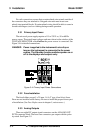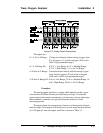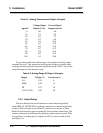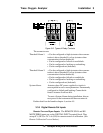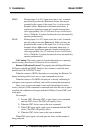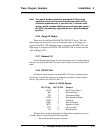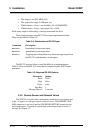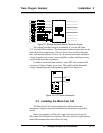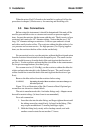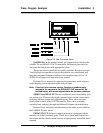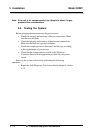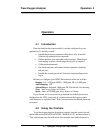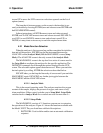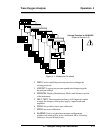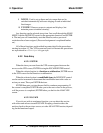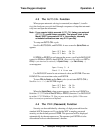
3 Installation Model 3020T
3-12
Teledyne Analytical Instruments
When the micro-Fuel Cell needs to be installed or replaced, follow the
procedures in chapter 5, Maintenance, for removing and installing cells.
3.5 Gas Connections
Before using this instrument, it should be determined if the unit will be
used for pressurized service or vacuum service and low pressure applica-
tions. Inspect the restrictor kit that came with the unit. The kit consist of two
restrictors and a union for 1/4” diameter tubing. Notice that the two 1 3/4”
long, 1/4” diameter tubing are restrictors. It has an open end and a closed
end with a small circular orifice. The restrictor without the blue sticker is for
;ow pressure and vacuum service. For high pressure (2 to 50 psig) applica-
tions, use the restrictor that has a blue sticker on the body.
For pressurized service, use the restrictor without the blue dot and union
from the restrictor kit and attach it to the Sample In port. The small circular
orifice should face away from the back of the unit (against the direction of
gas flow). Use the restrictor without the blue dot sticker in the same manner
for low pressure applications (less than 5 psig).
For vacuum service (5-10 in Hg), use the restrictor without the blue dot
sticker and union but attach it to the Exhaust Out port. The small circular
orifice should face toward the back of the unit (against the direction of gas
flow).
Remove the blue sticker from the restrictor before using.
WARNING: Operating the unit without restrictors can cause damage to t
the micro-fuel cell.
Figure 3-9 is an illustration of the Gas Connector Panel. Optional gas
connections are shown in a shaded block.
The unit is manufactured with
1
/4 inch tube fittings only. Adapters must
be used for metric tubing. (At least 6 mm is recommended.)
For a safe connection:
1. Insert the tube into the tube fitting, and finger-tighten the nut until
the tubing cannot be rotated freely, by hand, in the fitting. (This
may require an additional
1
/8 turn beyond finger-tight.)
2. Hold the fitting body steady with a backup wrench, and with
another wrench rotate the nut another 1
1
/4 turns.



